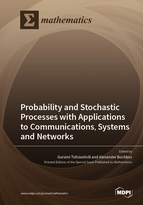Probability and Stochastic Processes with Applications to Communications, Systems and Networks
A special issue of Mathematics (ISSN 2227-7390). This special issue belongs to the section "Engineering Mathematics".
Deadline for manuscript submissions: closed (22 October 2022) | Viewed by 17493
Special Issue Editors
Interests: complex systems; mass service system stability; cooperativity in multiple stochastic systems; multiplicative theorems for queueing network
Special Issues, Collections and Topics in MDPI journals
Interests: non-stationary processes; risk assessment, analysis, and management; life-support systems; water purification electrochemical systems
Special Issues, Collections and Topics in MDPI journals
Special Issue Information
Dear Colleagues,
This Special Issue is devoted to probability, statistics, stochastic processes, and their different applications in systems and networks analysis. The Special Issue will include works related to the analysis and applications of different queuing models, which begin with general approaches in modeling queuing systems and networks. Large attention will be devoted to the analysis of probabilistic and statistical methods in telecommunication; Asymptotic analysis of queuing networks in the condition of a large load will be considered since original approaches are being developed in the asymptotic analysis of queuing networks in the condition of a large load and in the calculation of distributions in retrial queuing systems. We welcome the considerations of general complex networks and their structures, e.g., in terms of topology and graph theory, mathematical methods and models in smart cities, exclusive statistical methods, such as statistical estimates in bio/ecology, medicine, neural networks, and works that estimate parameters in complex technical systems, etc.
In general, topics include but are not limited to:
- General methods in complex networks and their structure analysis;
- Mathematical methods and stochastic models in smart cities;
- Statistical problems in ecological networks;
- Parameter estimation in complex systems;
- Analysis and applications of different queuing models;
- Polling systems and Jackson networks in random environments;
- Probabilistic and stochastic analysis in telecommunication systems;
- Risk analysis in complex technical systems.
Prof. Dr. Gurami Tsitsiashvili
Dr. Alexander Bochkov
Guest Editors
Manuscript Submission Information
Manuscripts should be submitted online at www.mdpi.com by registering and logging in to this website. Once you are registered, click here to go to the submission form. Manuscripts can be submitted until the deadline. All submissions that pass pre-check are peer-reviewed. Accepted papers will be published continuously in the journal (as soon as accepted) and will be listed together on the special issue website. Research articles, review articles as well as short communications are invited. For planned papers, a title and short abstract (about 100 words) can be sent to the Editorial Office for announcement on this website.
Submitted manuscripts should not have been published previously, nor be under consideration for publication elsewhere (except conference proceedings papers). All manuscripts are thoroughly refereed through a single-blind peer-review process. A guide for authors and other relevant information for submission of manuscripts is available on the Instructions for Authors page. Mathematics is an international peer-reviewed open access semimonthly journal published by MDPI.
Please visit the Instructions for Authors page before submitting a manuscript. The Article Processing Charge (APC) for publication in this open access journal is 2600 CHF (Swiss Francs). Submitted papers should be well formatted and use good English. Authors may use MDPI's English editing service prior to publication or during author revisions.
Keywords
- Probability, statistics, and stochastic processes
- Complex networks
- System analysis
- Queuing models
- Complex technical systems
- Risk analysis
- Reliability analysis
- Parameter estimation







